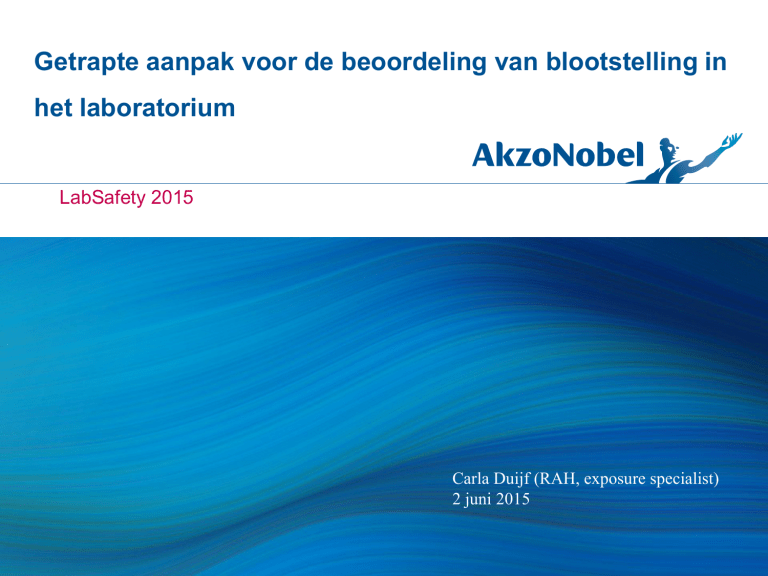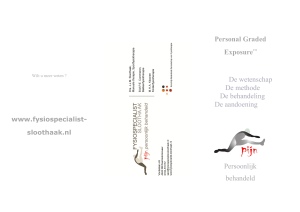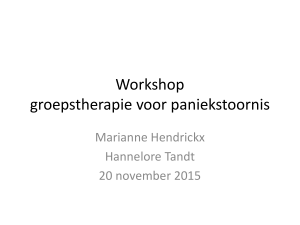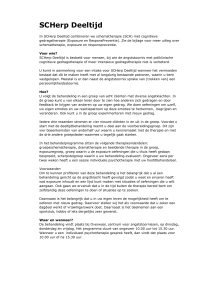
Getrapte aanpak voor de beoordeling van blootstelling in
het laboratorium
LabSafety 2015
Carla Duijf (RAH, exposure specialist)
2 juni 2015
Werkervaring AH
Blootstelling chemische stoffen
•
− Survey’s/ literatuur onderzoek/vragenlijsten
− Metingen i.s.m. universiteiten (stages; promotieonderzoek)
1990 – 2002
Universiteit en ziekenhuis
− Weet wat je meet.
•
Statistisch verantwoord. 3 – 12 meetsessies per handeling/taak
Doorlooptijd: maanden
Snellere (eerste) methode gewenst!
2002 – 2010
Industrie (farma)
−
•
2010 – 2015
Centrale afdeling AN
Kwalitatieve beoordeling van blootstelling en beheersmethode
− Semi kwantitatieve beoordeling en beheersmodellen.
o.a. EcetocTRA, ART, SkinPearm etc.
− Advies en ondersteuning.
Beoordeling blootstellingsrapportages. Kwaliteit van de
rapportages?
Standaardisatie nodig: Voorschriften.
Inhoud
• Inleiding ‘Beoordelen van de blootstelling’
• Kwalitatieve beoordeling:
Occupational Hygiene Risk Management
(OHRM)
• Kwantitatieve beoordeling: meten
• Message to take home
OHRM-lab
3
Inleiding
Beoordelen van de blootstelling
• Ken de risico’s en hoe die te beheersen:
Van algemene RI&E naar verdiepende RI&E.
• Plan van Aanpak:
Van kwalitatieve beoordeling naar meten.
Inzichtelijk en systematische aanpak
Resultaat gericht, gericht op de te nemen
beheersmaatregelen
Efficiënt
Kosten beheersing
OHRM-lab
4
Inleiding
Determinanten van gezondheidsrisico
Hazard
The intrinsic property of a
substance to cause health
effects;
•OEL
•R phrases; H statements
Exposure
The possibility to become
airborne;
•Volatility; Dustiness
•Handling
•Contact
RISK
The probability that it will
result in adverse health
effects
OHRM-lab
5
Inleiding regelgeving
Example
Acetonitrile
DNEL Workers
Inhalation(8H): 40 ppm
Dermal: 32.2 mg/kg bw/day
Exposure by inhalation
Proc 15 (lab): LEV (RCR: 0.05)
Vapour pressure: 121.4 hPa (25ºC)
OEL Workers
Inhalation(8H): 20 ppm
OHRM-lab
6
KWALITATIEVE BEOORDELING
OHRM-TOOL
OHRM-lab
7
The OHRM approach
1
Basic Process
Basic Process
Characterization
Characterization
3
Potential Degree
of Exposure
2
Hazard Class
4: Selection of
task based on
risk ranking
5: Occupational
Hygiene Control
Strategy
6: Monitoring
Evaluation
OHRM-lab
8
Overview of results
Process
Preparation
Task
Weighing
Stock
Agent/substance
at workplace
(stressor)
OEL
Hazard
Class (HC)
Potential
Degree of
Exposure
(PDE)
Task Risk
Ranking
(TRR)
Controls
AA
AA + B
solution
Dilute
Experiment
AA + B
Pipetting
Extraction
Preparation
analyses
Analyses
Extraction
AA + liquid C
HPLC
AA + C
eluent
D
OHRM-lab
9
Een voorbeeld
Het gebuik van Acetonitril als eluens in het laboratorium (<1 l)
OHRM-lab
10
Example of OHRM method:
Analyses by HPLC
Step 1
Basic Process Characterization
Use of acetonitrile (1 litre) as eluent
• Dilution (50%)
• Connecting the bottle
• Daily duration 2 hours
• Automatic process
• Check
OHRM-lab
11
Example: Analyses
Hazard Class of Acetonitrile
Step 2
• AkzoNobel Internal Exposure Limit (IEL)
34 mg/m3 or 20 ppm
• National OEL
(old) Dutch National OEL: 34 mg/m3 or 20 ppm
• The lowest Exposure Limit is leading!
• Hazard Class
2
OHRM-lab
12
Potential Degree of Exposure
Step 3
Five determinants of inhalation exposure:
• Material Characterization [MC]
• Aerosol Dispersion [AD]
• Quantity Handled [QH]
• Duration of Task [DT]
• Degree of Dilution [DD]
PDE = [MC] + [AD] + [QH] + [DT] + [DD]
(0-14) = (0-3) + (0-3) + (0-3) + (1-2) + (0-3)
PDE: Potential Degree of Exposure (sum of weighing factors of these
parameters)
OHRM-lab
13
Example: Analyses
Vapour Class of Acetonitrile
MSDS information
121.44 hPa at 25 °C
OHRM-lab
14
Example: Analyses
Potential Degree of Exposure (1)
Material Characteristic
Vapour pressure Acetonitrile (MSDS): 121.44 hPa (25°C), the weighing factor
is:
2
Weighing
factor
MC Descriptions
3
Very/extremely dusty
e.g. micronized particulates, carbon black,
cement, plaster, flour
2
Dusty
e.g. light, fine particles, soap powder, talc,
graphite
1
Slightly dusty
e.g. course particulates, soap granulates,
sugar, salt
0
Not dusty
e.g. solids, pellets, tablets, plastic granules
High vapour pressure liquid (> 100 mm Hg or
> 13.3 kPa) or
high volatility range based on boiling
temperature and operating temperature
(Figure 3.2)
Moderate vapour pressure liquid (20-100 mm
Hg or 2.7 – 13.3 kPa) or
medium volatility range based on boiling
temperature and operating temperature
(Figure 3.2)
Low vapour pressure liquid (1-20 mm Hg or
0.13 – 2.7 kPa) or
low volatility range based on boiling
temperature and operating temperature
(Figure 3.2)
Very low vapour pressure liquid (< 1 mmHg or
< 0.13 kPa)
OHRM-lab
15
Example: Analyses
Potential Degree of Exposure
PDE = [MC] + [AD] + [QH] + [DT] + [DD]
PDE = 2 + 1 + 3 + 2 + 3
PDE = 11
What control strategy is needed?
OHRM-lab
16
Step 4
1
Basic Process
Basic Process
Characterization
Characterization
3
Potential Degree
of Exposure
2
Hazard Class
4: Selection of
task based on
risk ranking
5: Occupational
Hygiene Control
Strategy
6: Monitoring
Evaluation
OHRM-lab 17
The Task Risk Ranking Matrix
HC= 2
When PDE= 11
Potential Degree
Hazard Class (HC)
of Exposure
TRR = Moderate
(PDE)
1
2
3
4
5**
1-4
5-8
Special attention
9-11
12-14
Low
Moderate
High
OHRM-lab
18
Example: Analyses
Occupational Hygiene Control Strategy
HC= 2
PDE = 11
Control selection: orange
Handlings
Specific control measures
Containment or isolation
Ventilation (exhaust)
Bench top
Final:
Which type of LEV?
Fixed places,
e.g. above bottles
OHRM-lab
19
KWANTITATIEVE BEOORDELING
HET METEN
OHRM-lab 20
Kwantitatieve beoordeling
•
Monstername methode?
Gevalideerd
Persoonsgebonden
Monstername snelheid (l/min)
Aantal blanco’s
Etc
•
Analytische methode beschikbaar?
Gevalideerd, recovery bekend
Detectiegrens van de meetmethode
<10% v.d. OEL?
Kwaliteit v.h. lab OK? Etc.
OHRM-lab 21
Air Monitoring
Figure 3.4 OHRM guidance
Step
1: TRR
2: Similar Exposure Group
3: Sampling Strategy
4: Evaluation
5: Supplementary Risk Management
Measures (RMM) needed?
6: Frequency monitoring
program
Business Unit | Title 22
Message to take home:
• Ga voor de getrapte beoordeling van het blootstellingsrisico.
– Van kwalitatief naar meten
• Wanneer aanvullende metingen?
– Voor het vastleggen van de te nemen bescherming(sfactor) (PBM;
containment; gesloten apparatuur)
– Bij onrust/twijfel over blootstelling
– Om de resultaten van de kwalitatieve beoordeling te controleren (bij twijfel)
• Enkele eisen t.a.v metingen:
– een gevalideerde monitoring/analysemethode
– de detectiegrens van de meetmethode: <10% van de grenswaarde
– Ijklijn tussen 10% en 200% van de grenswaarde
Laat je door een ervaringsdeskundige ondersteunen!
OHRM-lab 23
Dank u voor uw aandacht.
OHRM-lab 25
OHRM-lab 26
Detection limit of the method
Example
•
•
•
Flow rate pump: 2 L/min (info: sampling protocol)
Duration of task: 1 hour sampling time = 1 hour
Limit of Quantification (LoQ): 0.01 mg (info: lab)
•
•
•
Air sampling volume: 60 x 2 L= 120 L = 0.12 m3
LoQ = 0.01 mg
LoM : 0.01/0.12 = 0.08 mg/m3
E.g.: OEL: 1 mg/m3
Rule of thumb: concentration at workplace ≤ 10% OEL
OK!
Suppose: flow rate is 0.200 ml/min. The LoM: 10 times higher, so 0.8 mg/m3
Business Unit | Title 27
Hazard Classes and corresponding OEB
Hazard
Class
OEB
dust/ solid/
powder/low,
non-volatile
liquid
(mg/m3)
1
>1
OEB
medium/
high volatile
liquids*
(vapours)/
gases
(ppm)
>50
Risk
phrases
Hazard
statements
66 and all
others not
otherwise
listed
20, 21, 22,
36, 37, 38,
48, 62, 63,
65, 67
All others not
otherwise
listed
2
>0.1-1
>5-50
3
>0.01-0.1
>0.5-5
23, 24, 25,
34, 35, 37,
39, 41, 43,
48, 60, 61
301, 311, 314,
317, 318, 331,
335, 360, 371,
372
4
>0.001-0.01
>0.05-0.5
26, 27, 28,
40, 43, 48,
60, 61, 64,
68
300, 310, 317,
330, 341, 351,
360, 362, 370,
372
5
≤ 0.001
≤0.05
42, 45, 46,
49
334, 340, 350
302, 304, 312,
315, 319, 332,
335, 336, 361,
373
Remarks
R37/H335: moderately irritating to
airways
R48/H373: significant toxic effects at 10100 mg/kg bw
R62,63/H361: significant toxic
effects >30 mg/kg bw
R37/H335: strongly irritating to airways
R43/H317: moderate skin sensitizer
R48/H372: significant toxic effects at 110 mg/kg bw
R60,61/H360: significant toxic effects at
3-30 mg/kg bw
R43/H317: strong skin sensitizer
R48/H372: significant toxic effects at
0.1-1 mg/kg bw
R60,61/H360: significant toxic effects at
0.3-3 mg/kg bw
In case of mutagenic and/or
carcinogenic substances ask for expert
advice to set exposure level
OHRM-lab 28
Determination of the Hazard Class
Step 2
Occupational Exposure Limit (OEL)
• National or International OEL
http://www.dguv.de/dguv/ifa/Gefahrstoffdatenbanken/GESTIS-Internationale-Grenzwertef%c3%bcr-chemische-Substanzen-limit-values-for-chemical-agents/index.jsp
Internal Exposure Limit (IEL)
•
AkzoNobel IEL, based on:
National/International OEL
http://www.ser.nl/nl/themas/grenswaarden/overzicht%20van%20stoffen/a.aspx
DNEL or DMEL (REACH EU-legislation)
Safety Data Sheet (attention: be aware of preparation and/or reviewed
date) Occupational Exposure Band (OEB)
When toxicity data are insufficient. A toxicologist will determine the
OEB/HC. The mid value of the OEB will be the Internal Exposure Limit
(IEL)
OHRM-lab
29
Objectives of Task Risk Ranking
Task Risk Ranking is to prioritize:
Exposure Control Strategies
Exposure Assessment Strategies
o Collectively, to establish Similar Exposure Groups
(SEGs)
OHRM-lab
30












